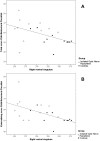Reduced ventral cingulum integrity and increased behavioral problems in children with isolated optic nerve hypoplasia and mild to moderate or no visual impairment
- PMID: 23554967
- PMCID: PMC3595222
- DOI: 10.1371/journal.pone.0059048
Reduced ventral cingulum integrity and increased behavioral problems in children with isolated optic nerve hypoplasia and mild to moderate or no visual impairment
Abstract
Objectives: To assess the prevalence of behavioral problems in children with isolated optic nerve hypoplasia, mild to moderate or no visual impairment, and no developmental delay. To identify white matter abnormalities that may provide neural correlates for any behavioral abnormalities identified.
Patients and methods: Eleven children with isolated optic nerve hypoplasia (mean age 5.9 years) underwent behavioral assessment and brain diffusion tensor imaging, Twenty four controls with isolated short stature (mean age 6.4 years) underwent MRI, 11 of whom also completed behavioral assessments. Fractional anisotropy images were processed using tract-based spatial statistics. Partial correlation between ventral cingulum, corpus callosum and optic radiation fractional anisotropy, and child behavioral checklist scores (controlled for age at scan and sex) was performed.
Results: Children with optic nerve hypoplasia had significantly higher scores on the child behavioral checklist (p<0.05) than controls (4 had scores in the clinically significant range). Ventral cingulum, corpus callosum and optic radiation fractional anisotropy were significantly reduced in children with optic nerve hypoplasia. Right ventral cingulum fractional anisotropy correlated with total and externalising child behavioral checklist scores (r = -0.52, p<0.02, r = -0.46, p<0.049 respectively). There were no significant correlations between left ventral cingulum, corpus callosum or optic radiation fractional anisotropy and behavioral scores.
Conclusions: Our findings suggest that children with optic nerve hypoplasia and mild to moderate or no visual impairment require behavioral assessment to determine the presence of clinically significant behavioral problems. Reduced structural integrity of the ventral cingulum correlated with behavioral scores, suggesting that these white matter abnormalities may be clinically significant. The presence of reduced fractional anisotropy in the optic radiations of children with mild to moderate or no visual impairment raises questions as to the pathogenesis of these changes which will need to be addressed by future studies.
Conflict of interest statement
Figures


Similar articles
-
Alterations in the optic radiations of very preterm children-Perinatal predictors and relationships with visual outcomes.Neuroimage Clin. 2013 Nov 28;4:145-53. doi: 10.1016/j.nicl.2013.11.007. eCollection 2014. Neuroimage Clin. 2013. PMID: 24371797 Free PMC article.
-
Organising white matter in a brain without corpus callosum fibres.Cortex. 2015 Feb;63:155-71. doi: 10.1016/j.cortex.2014.08.022. Epub 2014 Sep 11. Cortex. 2015. PMID: 25282054
-
Tract-specific analysis of white matter integrity disruption in schizophrenia.Psychiatry Res. 2012 Feb 28;201(2):136-43. doi: 10.1016/j.pscychresns.2011.07.010. Epub 2012 Mar 6. Psychiatry Res. 2012. PMID: 22398298
-
Effect of growth hormone deficiency on brain structure, motor function and cognition.Brain. 2012 Jan;135(Pt 1):216-27. doi: 10.1093/brain/awr305. Epub 2011 Nov 26. Brain. 2012. PMID: 22120144
-
Optic nerve hypoplasia.Oman J Ophthalmol. 2013 May;6(2):77-82. doi: 10.4103/0974-620X.116622. Oman J Ophthalmol. 2013. PMID: 24082663 Free PMC article. Review.
Cited by
-
Neurodevelopmental impairments in children with septo-optic dysplasia spectrum conditions: a systematic review.Mol Autism. 2023 Jul 25;14(1):26. doi: 10.1186/s13229-023-00559-0. Mol Autism. 2023. PMID: 37491272 Free PMC article.
-
Abnormal interhemispheric functional connectivity in patients with strabismic amblyopia: a resting-state fMRI study using voxel-mirrored homotopic connectivity.BMC Ophthalmol. 2021 Jun 9;21(1):255. doi: 10.1186/s12886-021-02015-0. BMC Ophthalmol. 2021. PMID: 34107904 Free PMC article.
-
Frontal EEG asymmetry and later behavior vulnerability in infants with congenital visual impairment.Clin Neurophysiol. 2017 Nov;128(11):2191-2199. doi: 10.1016/j.clinph.2017.08.016. Epub 2017 Sep 8. Clin Neurophysiol. 2017. PMID: 28950152 Free PMC article.
-
Brain structure in children with congenital visual disorders and visual impairment.Dev Med Child Neurol. 2020 Jan;62(1):125-131. doi: 10.1111/dmcn.14322. Epub 2019 Aug 8. Dev Med Child Neurol. 2020. PMID: 31393613 Free PMC article.
References
-
- Sonksen PM, Dale N (2002) Visual impairment in infancy: impact on neurodevelopmental and neurobiological processes. Dev Med Child Neurol 44: 782–791. - PubMed
-
- Tirosh E, Shnitzer MR, Davidovitch M, Cohen A (1998) Behavioural problems among visually impaired between 6 months and 5 years. Int J Rehabil Res 21: 63–69. - PubMed
-
- Jan JE, Freeman RD, Scott EP (1977) Visual impairment in children and adolescents. New York: Grune & Stratton.
-
- Kelberman D, Dattani MT (2007) Genetics of septo-optic dysplasia. Pituitary 10: 393–407. - PubMed
-
- Steinkuller PG, Du L, Gilbert C, Foster A, Collins ML, et al.. (1999) Childhood blindness. J AAPOS 3: 26–32. S1091853199000956 [pii]. - PubMed
Publication types
MeSH terms
LinkOut - more resources
Full Text Sources
Other Literature Sources
Medical

